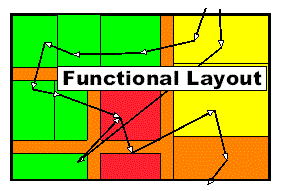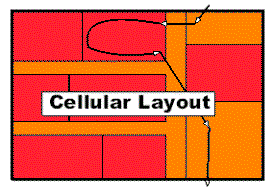Reducing Transaction Volume
Fewer Transactions; Fewer Errors
Error creation rate (errors per week) is roughly proportional to the number of transactions. Many systems require far more transactions than necessary and, thus, accumulate more errors than necessary. These errors must then be removed with cycle counting or physical inventory.
Reducing transaction volume improves accuracy and reduces cycle counting labor. It also reduces transaction input labor. In some instances, the cost of transactions exceeds the cost of items being tracked!
What Drives High Transaction Volume?
Complex Processes
Some inventory systems have excessive transactions because the underlying manufacturing process is complex and disjointed. Figure 8 illustrates how a functional layout and organization has complex material flows. the system may require two transactions for every material move.

Figure 8- Functional Layout
Functional layouts require many moves. Many moves require many transactions and increase the probability for error.

Figure 9 Cellular Layout
Cellular or "Product-Focused" layouts require fewer interdepartmental moves and fewer transactions. Fewer transactions produce fewer errors.
Data = Control Fallacy
People sometimes assume that more data makes for better control. However, this is only true when the data is both manageable and well-managed. It must be accessible, well-formatted, concise and monitored frequently. Many inventory systems are built with far too many transaction points under the assumption that this gives better inventory control.
One Method For Everything Assumption
Another unspoken assumption that sometimes underlies scheduling and inventory systems is the idea all products and processes should use a single method. This needlessly complicates a system. Most factories have a wide variety of products, volumes and demand characteristics. Some are amenable to simple, visual control while others are not. If one method is used for everything, that method is usually a complex computer-driven MRP/ERP system.
Unnecessary Data
Inventory system designers may collect data because it seems easy and the data might be useful. This may include unnecessary transactions. Once installed, the transactions are institutionalized and rarely get reviewed for necessity.
Reduce Transactions With...
Cellular Manufacturing
Cellular layouts can reduce material moves and transaction volume by 80% or more. compare figure 9 with figure 8. ...More on Cellular Manufacturing,
BOM Simplification
Complexity and unnecessary transactions may result from complexity in the BOM. Multiple layers of subassemblies seem to lend order and logic. These extra levels then carry over into manufacturing. The result is unnecessary inventory and transactions. BOM Simplification Example
Backflushing
In Backflushing, the inventory system is setup to relieve inventory of piece parts when a transaction is made for completion of an assembly. There may be several levels of subassembly in the BOM that the system assumes takes place. Backflushing and Phantom assemblies are alternatives to restructuring the BOM.
Kanban, Broadcast, Direct Link & ROP
Kanban and broadcast are simple visual systems that operate outside the MRP framework. Used
appropriately, they can simplify the scheduling and inventory system. for more on this, see our
page on Integrating kanban and Other methods.
![]()
■ ■ ■ ■ ■ ■ ■


